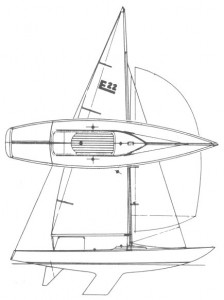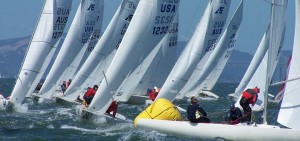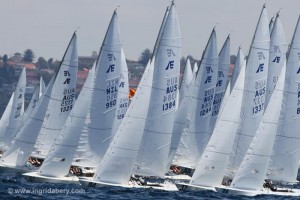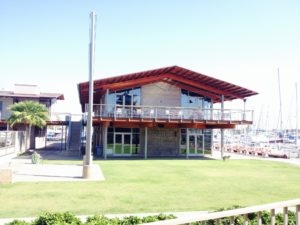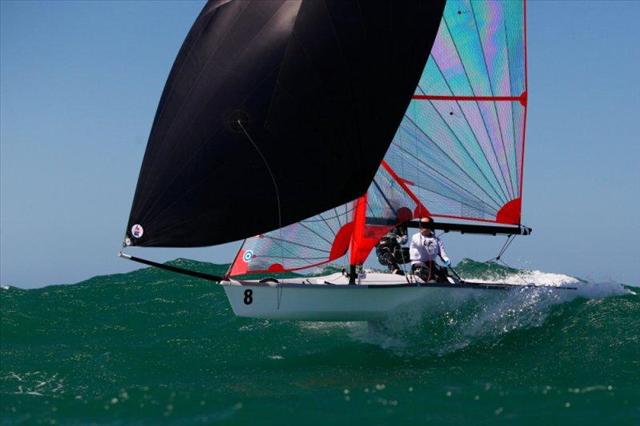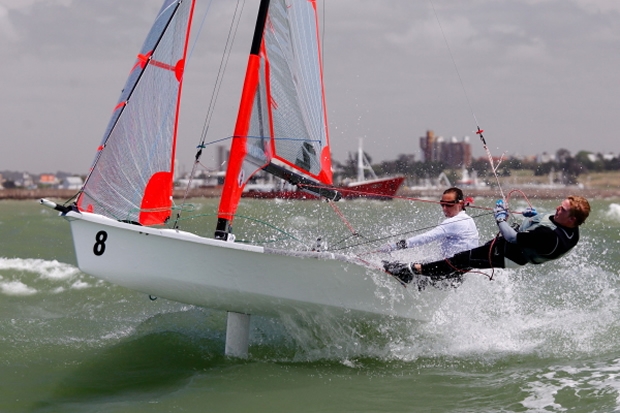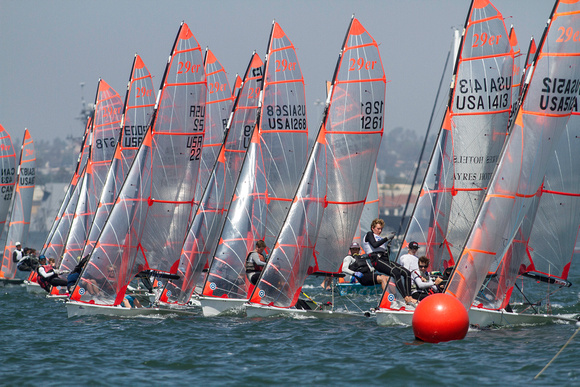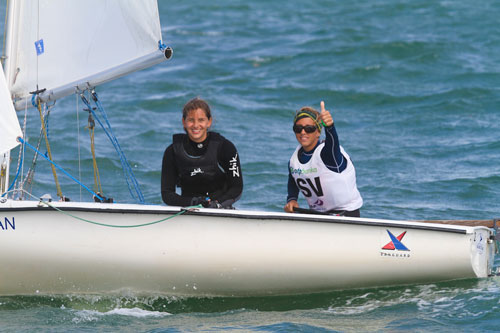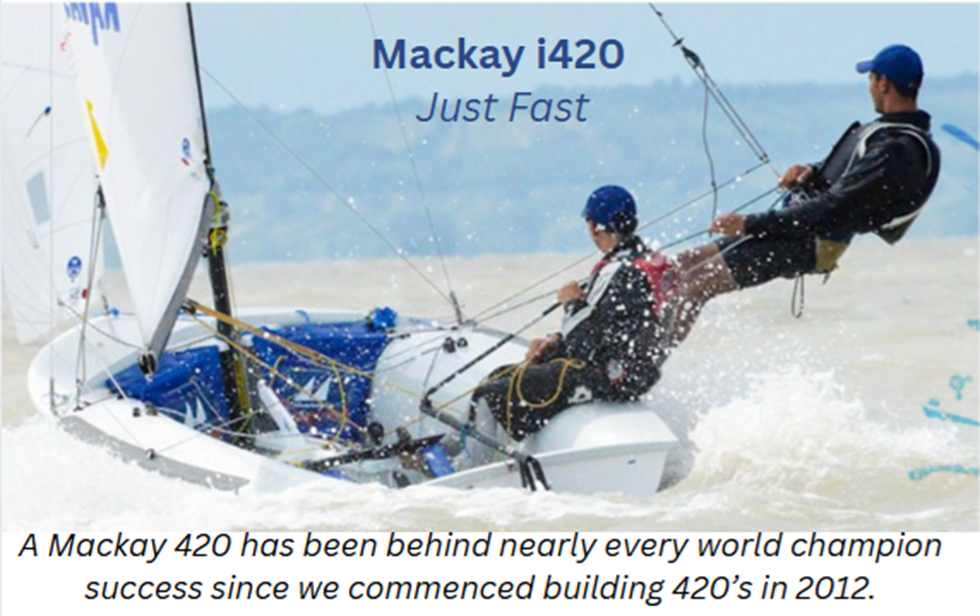By Airwaves writer Tyler Colvin
If any one-design class has a cult following, it would be the Etchells. The boat was designed in the mid 1960s by Skip Etchells as a candidate to be the three-man Olympic keelboat. Despite dominance in the trials, the Etchells lost out to the Soling, but gained a dedicated group of sailors. Since then, over 1200 hulls have been launched and sailed by individuals such as Dennis Conner who used the boat in training for his America’s Cup campaigns, Gary Jobson, Russell Coutts and Jud Smith.
The Boat: Heavenly
Long and slender, the Etchells is one of the larger 3-4 man keelboats in recent history. A narrow waist at 6’11” and a 22’ waterline belies an overall length of 30’6”. The boat displaces 3,700lbs all up and draws 4’6”. Described as “the boat they sail in heaven,” the Etchells is very tunable and responds to the smallest adjustments.
Commonly dry sailed, the Etchells is easily trailered despite her length. Construction is fiberglass with an aluminum rig. The class association monitors the class carefully to ensure parity across the fleet from new hulls to old. This allows the boat to retain value better than most other classes.
Sail plan involves a main, jib and spinnaker (188 square feet, 103 square feet, 400 square feet respectively). A large main sail and relatively small jib create extremely tight tacking angles (around 70 degrees) for the boat. The short waterline length reduces wetted surface and allows for very quick light-wind sailing. In heavier air the Etchells goes upwind “like a freight train” (Tim Etchells, Sailing World May 2000).
Set Up and Sailing: Upwind Machine
Set up is as simple as snapping jib hanks on, feeding main sail bolt rope into the track and casting off the lines. Of course, dry sailed boats may require a couple more steps before setting sail. A very good tuning guide can be found via Doyle Sails here (http://www.doylesails.com/onedesign/etchells/tuning.html).
Stay tension and position is used to control the mast bend and rake. Once adjusted, headstay, lower and upper shrouds should be tied off or locked to ensure they do not loosen while sailing. Backstay is the only stay tension adjusted on the water, using it to control the shape of the main to depower as necessary.
Similarly to the Lightning, mast chocks are used to further adjust rig shape while on the water. Mast chocks control mast pre-bend. Chocking behind the mast creates more pre-bend and vice versa. It is important to be checking headstay sag and jib shape while adjusting the chocks, as these settings are affected by mast bend.
In the Etchells, the jib drives the boat and encourages it to point unlike almost any other boat its size. In light winds, headstay sag should be adjusted by slacking the backstay and jib Cunningham to promote deeper draft and fuller sail shape. Higher wind conditions require more headstay tension (less sag) and jib Cunningham to draw the draft forward and flatten the sail. Jib sheets are trimmed through adjustable leads on cars; leads should be adjusted so that the telltales break evenly. Moving the car forward or back changes the sheeting angle and therefore the leach profile.
Main trim is a dynamic activity going upwind in an Etchells. The sail can be adjusted by a combination of the sheet and traveler. Just like on most boats with a mainsheet on a traveler, the sheet controls leach tension while traveler controls sheeting angle, not dissimilar to jib car position. In light air the traveler should be well up above centerline to allow the boom to be trimmed to centerline (or slightly above) while maintaining an open leach and flow. Ideally the top batten is parallel with the boom or slightly open. In heavier air the traveler car gets closer and closer to centerline with sheet tension increasing to increase leach tension. The backstay is trimmed in concert with the sheet/traveler as wind increases to flatten the sail.
Class Association: It’s the Boat, It’s the Fleet
After 48 years of existence, the Etchells class still draws a crowd. The 2014 Etchells World Championships in Newport, RI saw nearly 100 boats from around the world gather for some extremely competitive racing. Sailors such as current World Match Racing Circuit all star and former Boston College standout Taylor Canfield (USA 979, 2014 World Champions, Hardesty/Canfield/Roble/Eagan) went toe to toe with club sailors and weekend warriors through nine races over five days of racing out of the prestigious New York Yacht Club in conjunction with Sail Newport.
The North American Etchells Class website is very well organized, easy to follow and provides a plethora of resources for the emerging Etchells sailor (www.etchellsna.org). Class rules, schedules for North American and International competition, tips and tricks, contact information for all the class officers and boat/crew classifieds are available on the site.
Why Sail?
A pedigree of racing excellence, ease of set up, low cost of ownership and the support of an international class association. Is that enough reason? Beyond the racecourse, the Etchells is a joy to sail for all ages and abilities. A large cockpit, smooth responsive handling and a wide wind range combine for a pure sailing experience.
Club Profile: San Diego Yacht Club
By Katelyn Montero
If there was ever any doubt about San Diego’s ability to produce world-class sailors, skeptics should look no further than the San Diego Yacht Club. Founded in 1886, SDYC sailors are able to continually refine their skills on the water with the year-round sailing conditions found in America’s Finest City.
SDYC came from very humble beginnings, with a small group of dedicated sailors operating out of an old ferryboat. As they gained members, the young club moved around many locations in San Diego until finally setting at its present location in Point Loma in 1924. Since then, the facilities have grown immensely to accommodate a growing number of members, a world-class junior program and a large number of annual regattas. This year, the San Diego Yacht Club will host almost 50 regattas, ranging from member-only races to National and International competitions. The club is conveniently situated in Point Loma, giving racers access to both the open-water ocean racing of the Pacific and the calmer waters found inside the shelter of San Diego Bay.
In 2014, SDYC is now known across the world as the home to some of the world’s most accomplished sailors. Four-time America’s Cup winner Dennis Conner and J.J. Isler, the first woman ever to be inducted into the Sailing Hall of Fame, are just two of the esteemed sailors who sail out of SDYC.
The club is also a founding member of the National Sailing Hall of Fame. They are often named as a Platinum Club, a special title reserved for the top 5 private yacht clubs in the United States. In 2014, SDYC was ranked as the No. 2 yacht club in the United States. With their club motto “to encourage and foster interest in all aspects of yachting,” the San Diego Yacht Club has established a long history of involvement with racing and junior sailing.
The club is also ranked second in the best all-time final record for clubs who have won the America’s Cup, falling behind only the New York Yacht Club. SDYC is also the original home of the Lipton Cup, which will celebrate it’s centennial race this year from October 31to November 2, where the club will defend its current title as champions.
The Junior Sailing Program is one of the largest in the nation, and often produces competitive college sailors, world champions and Olympic hopefuls. During the summer of 2014, the junior program was home to 308 young sailors, many of whom continued on to participate in the year-round after school sailing program. Nearly exclusive to California sailing is the Sabot, a favorite for the SDYC junior program because beginners and adults can use the dinghy with its small, but accommodating size. Juniors at SDYC also sail 420s, CFJs and Lasers.
With many junior sailors training to compete at the high school level, it’s no surprise that SDYC also hosts practices for four of the local teams. The teams from Francis Parker, Bishop’s, Cathedral Catholic and Point Loma all sail out of SDYC. Many years, these teams go on to compete at a national level. The Point Loma High School Sailing Team recently won the Baker Trophy, making them ISA’s national team-racing champions.
The top-notch amenities and well-established reputation as a hub for world-class sailing is the reason why many members from the area have found their home at the San Diego Yacht Club. Over 2,000 members call SDYC home and enjoy the club’s expansive amenities. The facilities currently boast 578 boat slips, 161 dry storage slips for boats, tennis courts and a swimming pool. There are a total of 150 employees who work around the year to provide top amenities to members and guests.
http://www.sdyc.org/
One Design Class Profile: 29er
Youth sailing traditionally has been in dinghies designed 60 years ago with very few updates or improvements. The 29er changed all that when it was introduced in 1998 by acclaimed naval architect Julian Bethwaite. A high performance skiff aimed at young sailors, the 29er represents the future of the sport.
The Boat: The Next Big Thing
Skiff sailing has been popular down under in Australia and New Zealand for years in boats such as the International 14, Cherub Skuff and Aussie 18. These boats differ from the traditional dinghy hull design (such as 470, 5o5, etc.) having a very narrow bow entry, narrow hull with a flat exit and often-large wings that extend off the main hull. Skiffs have a large sail area for the size of the hull and rely on crew placement on a trapeze (sometimes skipper as well) to keep the boat flat. They will plane very quickly and can reach high speeds.
The 29er was developed from the 49er class as a youth trainer. It replaced the Laser 2 at ISAF Youth Worlds when it was introduced. Hull weight is a measly 150lbs, absolutely nothing for a 14’ boat. It gets its 5’7” width from the wings off the center hull. Sail area is 142 square feet for main and jib with a fractional asymmetrical spinnaker adding another 181 square feet of sail. The jib is self tacking, leaving the crew to manage main trim upwind.
Minimal hull weight is achieved by a fiberglass-reinforced polyester (GRP) and closed cell foam sandwich. The mast is constructed in three parts; aluminum mid and bottom sections and a lightweight fiberglass tip to reduce weight and increase mast flexion at the tip. Sails are made from Mylar and spinnaker from Nylon.
Former college sailor and current 29er sailor Dan Goldman loves the competition and speed of the 29er, “The boat is fun to sail because it is fast and challenging. The most challenging part [of 29er sailing] is keeping the boat upright in 20+ knots [of wind].”
Set Up and Sailing: Fast and Wet
The 29er is easily set up by two people and can go from the trailer to the water in a matter of minutes. The rig is light and tall; to step it the shroud adjusters are pinned to the chain plates, the mast butt is inserted into the mast step, and the mast is pulled forward and upright using the trapeze wires. From here, the boom, vang and control lines are connected and run through the appropriate blocks. A reliable set up guide can be found here (http://www.29er.org/images/stories/pdf/29er%20rigging_manual.pdf).
Weight position in the boat is important in all wind conditions. In light air, weight forward will reduce the amount of drag in the stern and cavitation off the back of the boat. As wind speed increases, moving weight back gets the bow out of waves and encourages the boat to plane. The 29er is a true skiff and likes to go fast; thusly it should be sailed fast. Upwind, stalling the boat by luffing in puffs or pinching will stop the boat quickly and should be avoided.
Because of the self-tacking jib, skipper/crew responsibilities are slightly different from a traditional double-handed boat. Sailing upwind the 29er skipper drives the boat and adjusts jib as needed and the crew trims main. Off the breeze the crew trims the gennaker and the skipper trims the main and drives. When sailing off the breeze the main should be kept trimmed to the back corner of the wing. This supports the mast and allows the boat to power up as apparent wind moves forward.
Class Association: International Acclaim
As an international class, the 29er benefits from support of organizing bodies around the world. The 2014 World Championships at CORK in Kingston, Ontario this year saw over 100 boats in three fleets from yacht clubs around the world. Class support for this boat has been huge; as the trainer for the Olympic 49er class, athlete development directly affects national team programs.
Why Sail?
The 29er brings to the table something few other, if any, classes that offer youth sailors competitive international events, fast technical sailing, and support from a large organizing body. “Fast is fun, and competing against the best in the world (C420 is NA only) is even more fun,” said Goldman. It is true, fast is fun and so is international competition. If the C420 circuit is getting a little stale, or you simply want to take a spin on a higher performance boat, the 29er is tomorrow’s youth trainer, today.
Balancing College with College Sailing
By Airwaves Writer Lydia Whiteford. We’ve all heard the classic college tagline, “between sleep, studying, and having fun, you can only pick two.” When you are also a college athlete, dedication to your sport is another variable that gets thrown into this mix. However, as I enter my final year of college, I find myself thinking that this stereotype may not be as true as people think. I believe that you can make the most out of your college experience in all aspects, even if there’s a lot on your plate. College sailors often have 30, and sometimes more, hours a week etched out of their schedules to dedicate to being on the water. So, as an experienced member of the college sailing world, I’ve compiled a “to do” list for those who are new to the game. Sooner than you think, you can find a way to juggle sailing, studies, and living your college life to the fullest.
1: Be Honest: This tip is threefold. The first person you need to be honest with is yourself. For example, if you have practice 4 days a week and regattas on weekends, are you really going to have time to take organic chemistry, head up your team’s social affairs, and sail full time on a varsity level? If you are, props to you because you might be superman. But if you don’t, that’s okay! Most people are, pun intended, in the same boat. What that means is that it is time to have a frank discussion with yourself on where you might have to allocate your time in order to be the most successful.
This brings me to my next point, which is to be honest with your coaches and professors. Make sure you keep an open dialogue with your coaches about how your classes are going; most of them uphold the popular motto that “school comes before everything.” If midterms are fast approaching and you are drowning in work, it is okay to miss a day or two of practice. It can sometimes feel like you are letting a coach or your teammates down by doing this, but that feeling can be avoided by telling your coach in advance how you are doing. A conversation on Monday that starts with, “hey coach, I have 2 papers and a test next week so I might have to miss Wednesday to go to office hours” will have a much better end result than a panicked email saying, “sorry no practice today way too much work” at the last minute. Along the same lines, it is equally important to be honest with your professors if something pops up in your athletic life that may affect your workload. I’ve found that it is valuable to discuss your extracurricular activities with your professors early, so that when the time of the season comes to head to Navy two weekends in a row, you can politely ask to be excused from a Friday class for traveling purposes without it being a surprise or sounding like an excuse. Many professors are very accommodating of college athletes, and as long as missing class does not become a habit, they are more than willing to grant you an absence if you need one.
The last group to be continually honest with are your friends. College sailors are on a different schedule than most other college athletes, and instead of having 2 halves that last 20-40 minutes each our “games” span 2 days, often for at least 6 hours a day, and most of the time they will be off campus. While this does allow for some intensely close bonding within the team, it can often leave non-sailor friends by the wayside. The best way to manage relationships with these friends when you can’t go out on the weekends is to work hard to plan other meeting times. Lunch together in the cafeteria or study sessions in the library together are great places to start until you know each other’s schedules, and then things will fall into place more easily as long as both parties understand the limits of availability.
2: Use Your Free Time Wisely: The first thing that most new college sailors will learn is that sailing takes up a lot of time. After practice, regattas, meetings, and “team bonding” every week it can soon feel like everything you do revolves around college sailing. The most important thing to remember in these times is that the more you plan ahead, the fewer nights you will spend staying up until 4 am frantically scrambling to do neglected work. Take advantage of the time you have during the day; an hour or two between class is perfect for getting some reading or studying done. Allocate days of the week so that some are for work and some are for socializing – days off of practice are usually good working days, as they are usually earlier in the week. Also, if there is a particular social event you know you won’t want to miss, know that you may have to sacrifice more of your after practice hours to studying in order to free time up. Get to know your classes to prioritize work (learn the critical art of skimming!) This will help with knowing what work will be imperative to keep up with and what can be moved around on your list.
The off-season is a critical time to keep up with good work habits, because you lose the structure of practice and regattas to keep everything moving forward. It is easy come December to think “Oh boy! No more practice for 3 hours a day! Free weekends! I will finally have time to do all the work I need to!” but often, what this quickly turns into is “Oh boy! 3 extra hours to watch Netflix! I’d usually be at practice now and it’s cold outside so just one more episode of House of Cards couldn’t hurt.” Don’t fall into this trap! Work with the free time if you have it, and before you know it, you may even be ahead on work come March when the season starts again.
Most importantly, if you start to feel overwhelmed and run-down, take a break. If you need to sleep, make sure you do! Your teammates will forgive you if you decide to stay in for a night to catch up on some rest. Coaches and professors don’t get disappointed in people who simply have too much on their plates, they only get disappointed in people who slip in performance because they clearly weren’t taking care of themselves.
3: When in Doubt, Lean on your Teammates: Sometimes the unavoidable happens, and the hectic tornado of stuff that college kids have to worry about swallows us all up. If this happens to you, don’t panic, and take some deep breaths because I have some good news for you. You have teammates, several of which are in your class and are probably going through the exact same things as you. Or, even better, you have upperclassman teammates and alumni that went through it all already and lived to tell the tale. Use these people to your advantage, and be there when they need you to be. Ask for advice when you need it, vent when you have to, and bind together to try and get over hurdles like extra hard classes or tough regatta weekends. Because, in the end, nobody knows the ups and downs of college sailing quite as well as other college sailors. Your teammates will quickly turn into family as you all try to navigate sailing, school, and social life to come out on the other end unscathed.
44th Hobie 16 Open North American Championships Final Results
44th Hobie 16 Open North American Championships and 2015 Pan Am Games qualifier
Lewes Yacht Club, Lewes DE
Lewes, DE (September 27, 2014): The 44th Hobie 16 North American championships concluded on Friday with Jason Hess and Irene Abascal from Club Los Sauces, Guatemala taking the title. Mark and Grace Modderman from Long Branch, New Jersey followed in 2nd place and Pedro Colon and Monica Cabrera from Puerto Rico in third winning the tie break over Dan Borg and Liana Giovana from Canada. Nine races were completed with 4 races held on the last day of the regatta. An early fall Nor’easter wreaked havoc on the regatta, postponing races for 2 days. The competitors were greeted to a beautiful day for the last day of racing with sunshine and Northerly winds that started out near 18 knots and faded during the day. The event is also a Pan Am Games Country qualifier, with the top team from the top 3 countries (not including the host country, Canada) qualifying for the 2015 Pan Am games to be held in Toronto, Canada. The top three nations are Guatemala, United States and Puerto Rico. The top three US teams are Mark and Grace Modderman(2nd), Rich McVeigh and Carol Hilk (6th) and Paul and MaryAnn Hess (7th). The US representative to the Pan Am games is still to be determined.
More results can be found at http://www.regattanetwork.com/clubmgmt/applet_regatta_results.php?regatta_id=7949&show_crew=1
and photos can be found at http://www.walkerphotography.ca/2014-Hobie-16-North-Americans .
and at the capegazette, http://capegazette.villagesoup.com/p/day-3-rough-seas-force-postponement/1244716?cid=2271494
US TEAM RACING CHAMPIONSHIP FINAL RESULTS 2014
Final Report (courtesy of US Sailing)
MARBLEHEAD, Mass. (September 28, 2014) – The final day of the 2014 U.S. Team Racing Championship ended up being a half day of sailing due to a complete shutdown of the wind. However, the fleet completed enough races to count Gold Round Robin 3 and crown Ladies and Gentlemen as the back-to-back Team Racing Champions. The championship team which includes Tyler Sinks (San Diego, Calif.), Lucy Wallace (Middletown, R.I.), Justin Law (Balboa, Calif.), Adrienne Patterson (Miami, Fla.), Michael Menninger (San Francisco, Calif.) and Ben Lezin (Santa Cruz, Calif.) will qualify for the 2015 ISAF Team Racing World Championship being held at the Rutland Sailing Club in Great Britain from July 19th-24th of next year. Team Do Less which includes Colin Smith (Ft. Lauderdale, Calif.), Annalee Leggett (Boston, Mass.), Chris Barnard (Newport Beach, Calif.), Brooks Clark (Charleston, S.C.), Sean Bouchard (Bristol, R.I.), and Victoria Lynch (Bronx, N.Y.) will also qualify for the World Championship.
Final Standings – Top 6 Teams
1. Ladies and Gentlemen, 15 points
2. Do Less, 14 points
3. Team Shred, 13 points
4. Hoodrat S.W.O.F., 9 points
5(T). Hawks Peacocks, 8 points
5(T). Kirkwood Ticklers, 8 points
– See more at: http://www.ussailing.org/racing/championships/adult/teamracing/#sthash.c1NwoAvF.dpuf
2014 505 East Coast Championship Final Results
Series Standing – 5 races scored
Information is provisional and subject to modification
Regatta results saved: Sunday, September 21, 2014 11:16:55 AM EDT
Division: 505 (32 boats) (top)
| Pos | Sail | Skipper | Crew | Club | 1 | 2 | 3 | 4 | 5 | Total Points |
Pos |
| 1 | 8808 | Diaz, Augie | Woelfel | CRYC/BBYC | [12] | 1 | 1 | 8 | 1 | 11.00 | 1 |
| 2 | 8830 | Zagol, Mark | Butner, Drew | NESS | 1 | 4 | 3 | [7] | 4 | 12.00 | 2 |
| 3 | 8913 | Herlihy, Dan | Ewenson/Smi, Geoff/Carl | FBYC | 4 | [10] | 4 | 1 | 5 | 14.00 | 3 |
| 4 | 13 | Moore, Tyler | O’Bryan, Patrick | Hampton YC | 2 | 2 | [17] | 10 | 2 | 16.00 | 4 |
| 5 | 8854 | Thompson, Craig | Turowski, Carson | Kittery Point YC | 7 | 9 | 6 | 3 | [18] | 25.00 | 5 |
| 6 | 9095 | Nelson, Macy | Barclay, Parry | WRSC | 5 | [15] | 8 | 5 | 8 | 26.00 | 6 |
| 7 | 9041 | Amthor, Henry | Romey, Dustin | Hampton YC | 10 | 5 | 2 | [25] | 10 | 27.00 | 7 |
| 8 | 8838 | Storck, John | Rei, Alden | Storm Trysail Club | 8 | 7 | 10 | [17] | 3 | 28.00 | 8 |
| 9 | 8715 | Moon, Ben | Booth, Eric | 6 | 3 | [19] | 6 | 14 | 29.00 | 9 | |
| 10 | 8264 | Boyd, Jeff | Crothers, Gord | Kingston YC | 15 | [19] | 9 | 2 | 9 | 35.00 | 10 |
| 11 | 8821 | Komar, Michael | Grove, Ervin | Newport, RI | [18] | 12 | 5 | 15 | 7 | 39.00 | 11 |
| 12 | 7200 | Meller, Ali | Coe, Mike | SSA | 3 | [14] | 12 | 12 | 13 | 40.00 | 12 |
| 13 | 8194 | Ferraone, Ted | James, Clayton | Larchmont YC | 11 | 6 | 11 | [14] | 12 | 40.00 | 13 |
| 14 | 8722 | Phillips, Jonathan | Averil/Nelson, Kelsey | SSA | 9 | 8 | 7 | [19] | 17 | 41.00 | 14 |
| 15 | 7346 | Jones, Andrew | Marks, Zack | SPYC | [24] | 11 | 18 | 9 | 6 | 44.00 | 15 |
| 16 | 8 | Conners, Ian | Miller, Russell | SSA | [19] | 13 | 13 | 4 | 16 | 46.00 | 16 |
| 17 | 9005 | Kivney, Tom | Russell, Gordon | Region 1 | [21] | 20 | 14 | 11 | 11 | 56.00 | 17 |
| 18 | 7773 | Delfosse, Duane | Marini, Sol | LSYC | 13 | [18] | 15 | 13 | 15 | 56.00 | 18 |
| 19 | 7606 | Connell, Brendan | Heussler, Brendan | 14 | [24] | 22 | 16 | 21 | 73.00 | 19 | |
| 20 | 9003 | Falsone, Jesse | Russell, Clayton | SSA | 22 | 16 | [24] | 18 | 19 | 75.00 | 20 |
| 21 | 7199 | Papadakis, Stergios | Anderson, Eric | SSA | 16 | 21 | 21 | 20 | [23] | 78.00 | 21 |
| 22 | 7359 | Brady, Catherine | Brady, Christopher | SSA | 17 | [27] | 25 | 21 | 20 | 83.00 | 22 |
| 23 | 8883 | Scannell, Peter | Renda, Michael | WRSC | 20 | 23 | 20 | 22 | [33/DNC] | 85.00 | 23 |
| 24 | 8851 | Huebner, Amy | Huebner, Ted | Hampton YC | 25 | 17 | 16 | [33/DNC] | 33/DNC | 91.00 | 24 |
| 25 | 8939 | Wyles, John | Fletcher, Gareth | 27 | 22 | 23 | [29] | 26 | 98.00 | 25 | |
| 26 | 8850 | Watson, Doug | Stanton, Pete | WRSC | 23 | 26 | 26 | 23 | [33/DNS] | 98.00 | 26 |
| 27 | 8919 | Schoene, Lauren | Richardson, Bryan | SSA | 26 | 25 | [31] | 24 | 25 | 100.00 | 27 |
| 28 | 8822 | Burchfiel, David | Forman, Andy | Carolina SC | 28 | [33/DNS] | 27 | 26 | 22 | 103.00 | 28 |
| 29 | 8951 | Rasmussen, Christian | Cravits, Mike | Hampton YC | [29] | 29 | 29 | 28 | 24 | 110.00 | 29 |
| 30 | 8244 | Esbensen, Gretchen | Andron, Paul | SSA | 30 | 28 | 28 | 27 | [33/DNC] | 113.00 | 30 |
| 31 | 919 | Hidalgo, Joseph | Dorfman, Avram | SSA | [33/DNF] | 33/RAF | 30 | 33/DNF | 33/DNC | 129.00 | 31 |
| 32 | 8059 | Neal, David | Korpella, Sherri | SSA | [33/DNC] | 33/DNC | 33/DNC | 33/DNF | 33/DNC | 132.00 | 32 |
Notes
| (1) | Scoring System is ISAF Low Point 2009-2012 |
| (2) | Finishes in [brackets] denote throwouts |
One Design Notebook: Developing a Team Position Chart
By Airwaves Writer Andrew Kerr
One of the hardest things for a team to do is to field the same team at every race or regatta – inevitably someone cannot make the event and the team has to adapt with new crew, it is the reality of life that just about every team has to adapt to.
As a coach I recognize this fully and have formulated team position charts for different types of boats so that the team has a blue print on how to plug someone new in as seamlessly as possible, the most challenging scenario very often is on bigger boats where there are more team members and very often more complexity than smaller boats teams experience.
The position chart that I use as an example is for a J/120 team sailing in PHRF and like all the charts, is very flexible in terms of how it is applied as regards to the experience level of the new crew and who they may be replacing.
CrewPositionchart
The chart has been very useful as a training tool in helping develop the foundational structure of the teams individual responsibilities around the race course, in some instances I have expanded it to include roles at the dock prior to and after racing, roles and a check list in between races – who packs the spinnaker, keeping the boat close to the starting line etc. as well as the team debrief with a team member taking notes or filming the session.
To start developing your own chart I recommend interviewing each team member on their role going around the race course, fine tune it then implement it in the next practice session or in the pre-race practice session . The chart is continuously developed and fine-tuned after each regatta and really does help provide a blue print for who does what when – especially if you notice three people up on the bow during a Spinnaker takedown doing one person’s job !
Club 420 Association Announces New Winter Series
North Kingston, RI (September 19, 2014) — The Club 420 Association today announced the new c420 Winter Series 2014 which will include the 2014 Orange Bowl Regatta, the 2015 Boomerang Regatta and the 2015 c420 Midwinters.
Building on the success of the summer c420 series, The Triple Crown, the c420 Class has designed the 2014-15 Winter Series to bring some of the popular winter events together into a point series at three great venues. The regattas counted towards the winter series will be the 2014 Orange Bowl (Dec. 26-30), the 2015 Boomerang Regatta (Late Jan.) and the 2015 c420 Midwinters (Feb. 14-16). The regatta series will move north up the east coast of Florida each event from Miami, to Ft. Lauderdale and finally to Jensen Beach.
The c420 class is not only about providing great regatta opportunities but also about providing great access for our sailors to coaches and quality information for every sailor in the class to improve. As a prelude to the new Winter Series, the c420 class is proud to present the Warm-Up Clinic, hosted by Biscayne Bay Yacht Club. This clinic will be a three day (Dec. 21-23) educational experience where sailors will be exposed to great college coaches like Justin Assad (Dartmouth College), John Mollicone (Brown University), Kevin Reali (Eckerd College). For more information on this great clinic go to www.club420.org
After getting some great coaching at the Warm Up Clinic sailors have three quality regattas to look forward to in three very different venues. “What stands out to me the most about this series is the opportunity to race against the best junior sailors in the country in three very distinct venues” commented class director John Vandemoer. “Club 420 sailors will have a chance to sail in beautiful Biscayne Bay, the home for many top level international regattas; in January the boats move north to Lauderdale to a fantastic ocean venue at Lauderdale Yacht Club with waves and great breeze. To top it all off we head to the home of winter c420 sailing in Jensen Beach at the US Sailing Center of Martin County which can provide a little of everything.”
The Winter Series rules and regatta details will be announced at www.club420.org. Registration has just opened up for the Orange Bowl regatta and there is a limit of 100 boats so register quickly to insure your place. Boomerang and Midwinters will open up their registrations soon.
Orange Bowl: http://www.coralreefyachtclub.org/Waterfront/orange-Bowl-Regatta/COMPETITORS.aspx
Boomerang: http://www.lyc.org/web/guest/regattas
C420 Midwinters: http://www.usscmc.org
About The Club 420 Class Association
The Club 420 Association was established in 1980 to promote, foster, encourage and sponsor one-design sailing. The Association sponsors a class North American Championship, US and Canadian National Championships as well as regional championships for the class across North America while promoting the class to all ability and experience levels of youth sailing. Since 2006, the class membership has more than doubled from 300 to its current 715 members. The class offers many regional, national and North American championships in both fleet and team racing formats as well as clinics across North America. Our Nationals / North Americans have had 175 boats attend, with all levels of sailors competing in some of the finest and socially fun regattas you will attend.
About The Club 420
The Club 420 is a two person dingy which forms the base of many local, high school and collegiate programs in North America. Simple for beginning sailors and yet challenging enough for collegiate champions. The Club 420 offers more learning opportunities than any other double-handed boat you can find. Over 5,000 Club 420s are sailed in youth, high school and collegiate programs all over the United States, Canada, Mexico and the Caribbean.
For more information please visit our website at www.club420.org or visit us on Facebook
Contact:
John Vandemoer, Executive Director
Email – [email protected]
44th Hobie 16 Open North American Championships and 2015 Pan Am Games Qualifier
Lewes Yacht Club, Lewes DE
Pre-event Press Release
Lewes, DE (September 17, 2014): 50 to 60 teams from all across North America will be descending on Lewes Delaware and the Lewes Yacht Club for the 44th Hobie 16 North American Championships. Racing is scheduled to begin Monday, September 22, 2014 on the classic Hobie 16 just off the beach in the Delaware Bay. Four to five races are expected to be held every day for 5 days with the champion being crowned on Friday. The event is also a Pan Am Games Country qualifier, with the top team from the top 3 countries (not including the host country, Canada) qualifying for the 2015 Pan Am games to be held in Toronto, Canada. The top finishing US team will qualify to represent the USA in the Pan Am games. Currently, teams from USA, Canada, Guatemala, Puerto Rico and Venezuela are registered. Many former North American Champions and other top sailors in the class will be in attendance so the racing will be exciting.
In addition to the competitive racing scheduled, the event is highlighted by a presentation by Gary Jobson. Also, the Hobie Class Association in partnership with the Hobie Cat Co. will create a promotional video featuring Hobie 16 sailing to be filmed during the 2014 Hobie 16 North American Championships. Gary Jobson Sailing, Inc will create and produce the video.
About Hobie Class Association of North America: The Hobie Class of North America, as a regional association of the International Hobie Class Association (IHCA) carries on the “Hobie Way of Life” tradition that Hobie Alter started over 50 years ago. We organize regattas (including women’s and youth events), publish the quarterly HOTLINE magazine, organize Guest Expert Programs, provide grants to deserving youth sailors and a host of other services. For more information visit: http://www.hcana.hobieclass.com/
Lewes Yacht Club: http://www.lewesyc.com/ Pan Am games: http://panamsailing.org/
Event Media contact: Greg Raybon 732-939-5414, [email protected]
Hobie 16 North Americans Website
Event Chairs: Rich McVeigh – 301-526-6046, [email protected]
Mark Santorelli – 908-783-1915, [email protected]
2014 J/70 World Championship Final Results
| ne Design Division | ||||||||||||||||||||||||||||
| GOLD Fleet | ||||||||||||||||||||||||||||
| 1. |  |
USA 2 | Helly Hansen | Tim Healy | 2 | 2 | 2 | 1 | 3 | 2 | 1 | 1 | 13 | 4 | 8 | 2 | [13] | 28.0 | ||||||||||
| 2. |  |
USA 187 | Catapult | Joel Ronning | 1 | 1 | 1 | 4 | 8 | 1 | 2 | 14 | 10 | 1 | 4 | 6 | [14] | 39.0 | ||||||||||
| 3. |  |
USA 96 | Savasana | Brian Keane | 1 | 3 | 3 | 2 | 11 | 16 | 9 | 11 | 1 | 3 | 25 | 1 | [25] | 61.0 | ||||||||||
| 4. |  |
USA 246 | New Wave | Martin Kullman | 6 | 24 | 6 | 3 | 2 | 3 | 7 | 28 | 4 | 13 | 1 | 14 | [28] | 83.0 | ||||||||||
| 5. |  |
USA 95 | MUSE | Heather/Joe Gregg Earl/Bardenheier | 23 | 13 | 9 | 11 | 13 | 5 | 4 | 3 | 2 | 7 | 11 | 5 | [23] | 83.0 | ||||||||||
| 6. |  |
USA 86 | Stampede//Pour Judgement Racing | Patrick Wilson | 7 | 12 | 13 | 5 | 14 | 15 | 3 | 6 | 19 | 11 | 6 | 4 | [19] | 96.0 | ||||||||||
| 7. |  |
USA 55 | Joust | Tim Molony | 16 | 2 | 6 | 2 | 37 | 7 | 6 | 20 | 11 | 12 | 20 | 3 | [37] | 105.0 | ||||||||||
| 8. |  |
BRA 403 | Bruschetta | Mauricio Santa Cruz | 5 | 6 | 4 | 3 | 1 | 25 | 31 | 24 | 17 | 19 | 15 | 10 | [31] | 129.0 | ||||||||||
| 9. |  |
USA 179 | Africa | Jud Smith | 14 | 10 | 14 | 20 | 1 | 10 | 19 | 4 | 3 | 22 | 14 | 35 | [35] | 131.0 | ||||||||||
| 10. |  |
NED 69 | Bliksem | Pieter Taselaar | 8 | 14 | 33 | 15 | 2 | 9 | 18 | 2 | 26 | 15 | 16 | 7 | [33] | 132.0 | ||||||||||
| 11. |  |
USA 353 | Heartbreaker | Robert Hughes | 7 | 20 | 5 | 14 | 3 | 4 | 16 | 18 | 9 | 10 | 36 | 33 | [36] | 139.0 | ||||||||||
| 12. |  |
USA 45 | Wild Child | Henry Filter | 17/SCP | 1 | 7/SCP | 6 | 4 | 19 | 27 | 9 | 14 | 24 | 39 | 18 | [39] | 146.0 | ||||||||||
| 13. |  |
USA 85 | Dazzler | Allan Terhune, Jr | 28 | 35 | 2 | 12 | 7 | 6 | 11 | 10 | 29 | 20 | 10 | 11 | [35] | 146.0 | ||||||||||
| 14. |  |
USA 209 | Trouble | Peter McChesney | 5 | 29 | 18 | 9 | 4 | 33 | 22 | 16 | 8 | 14 | 9 | 17 | [33] | 151.0 | ||||||||||
| 15. |  |
USA 217 | Joint Custody | Jenn & Ray Wulff | 6 | 5 | 12 | 10 | 17 | 12 | 36 | 33 | 5 | 9 | 28 | 20 | [36] | 157.0 | ||||||||||
| 16. |  |
GBR 123 | Team RAFBF Spitfire | Simon Ling | 2 | 10 | 11 | 7 | 7 | 20 | 28 | 39 | 6 | 16 | 35 | 25 | [39] | 167.0 | ||||||||||
| 17. |  |
USA 482 | X | Dan Cheresh | 4 | 17 | 27 | 6 | 28 | 35 | 17 | 35 | 20 | 6 | 2 | 8 | [35] | 170.0 | ||||||||||
| 18. |  |
USA 69 | USA 69 | Joseph Colling / Lee Sackett | 3 | 21 | 4 | 20 | 12 | 8 | 32 | 13 | 34 | 17 | 23 | 19 | [34] | 172.0 | ||||||||||
| 19. |  |
USA 326 | Aquaholiks | Martin Johnsson | 28 | 12 | 11 | 13 | 9 | 17 | 10 | 5 | 21 | 21 | 41 | 26 | [41] | 173.0 | ||||||||||
| 20. |  |
USA 94 | Lifted | Jim Cunningham | 10 | 4 | 1 | 11 | 15 | 22 | 33/SCP | 12 | 43 | 23 | 37 | 22/ZFP | [43] | 190.0 | ||||||||||
| 21. |  |
USA 49 | Relative Obscurity | Peter Duncan | 25 | 8 | 17 | 8 | 11 | 38 | 33 | 7 | 37 | 8 | 29 | 9 | [38] | 192.0 | ||||||||||
| 22. |  |
USA 48 | Rascal | Will Welles | 3 | 14 | 19 | 33 | 40 | 24 | 5 | 8 | 31 | 29 | 13 | 16 | [40] | 195.0 | ||||||||||
| 23. |  |
USA 34 | Perseverance | Bennet Greenwald | 24 | 9 | 13 | 22 | 38 | 14 | 14 | 15 | 24 | 2 | 43 | 23 | [43] | 198.0 | ||||||||||
| 24. |  |
USA 390 | 20/20 | John Arendshorst | 12 | 7 | 5 | 1 | 30 | 43 | 15 | 36 | 25 | 36 | 12 | 28 | [43] | 207.0 | ||||||||||
| 25. |  |
GBR 557 | Boats.com | Ian Atkins | 4 | 23 | 3 | 5 | 24 | 32 | 40 | 23 | 16 | 25 | 31 | 22 | [40] | 208.0 | ||||||||||
| 26. |  |
USA 51 | Black River Racing | Doug Strebel | 9 | 42/ZFP | 26 | 15 | 6 | 23 | 12 | 44/OCS | 18 | 5 | 24 | 31 | [44] | 211.0 | ||||||||||
| 27. |  |
USA 171 | Running Wild | Peter Vessella | 13 | 3 | 23 | 24 | 20 | 13 | 13 | 30 | 12 | 31 | 42 | 39 | [42] | 221.0 | ||||||||||
| 28. |  |
CHI 680 | Flecha | Felipe Robles | 26 | 8 | 14 | 25 | 10 | 26 | 34 | 17 | 36 | 32 | 3 | 27 | [36] | 222.0 | ||||||||||
| 29. |  |
USA 157 | Spring | Dave Franzel | 15 | 7 | 12 | 12 | 9 | 29 | 42 | 34 | 30 | 30 | 32 | 12 | [42] | 222.0 | ||||||||||
| 30. |  |
USA 375 | Lickity Split | Stanley Edwards | 8 | 18 | 27 | 10 | 26 | 21 | 26 | 29 | 38 | 27 | 5 | 29 | [38] | 226.0 | ||||||||||
| 31. |  |
MEX 690 | Vincitore | Erik Brockmann | 18 | 16 | 7 | 17 | 6 | 36 | 21 | 38 | 15 | 35 | 40 | 24 | [40] | 233.0 | ||||||||||
| 32. |  |
USA 340 | Rimette | John Brim | 22 | 15 | 8 | 25 | 22 | 27 | 8 | 41 | 22 | 18 | 33 | 38 | [41] | 238.0 | ||||||||||
| 33. |  |
USA 40 | B Squared | Bryan Cameron & Brian Elliott | 12 | 5 | 20 | 24 | 22 | 28 | 25 | 26 | 23 | 40 | 17 | 40 | [40] | 242.0 | ||||||||||
| 34. |  |
USA 397 | Hot Mess | Rob Britts | 13 | 11 | 24 | 13 | 15 | 34 | 30 | 19 | 42 | 38 | 7 | 41 | [42] | 245.0 | ||||||||||
| 35. |  |
USA 167 | Kraken | Gary Tisdale / Adam Burns | 20 | 31 | 9 | 22 | 5 | 30 | 39 | 22 | 28 | 26 | 22 | 34 | [39] | 249.0 | ||||||||||
| 36. |  |
USA 11 | Menace | Kerry Klingler | 11 | 44/ZFP | 36 | 14 | 10 | 11 | 20 | 37 | 35 | 34 | 26 | 15 | [44] | 249.0 | ||||||||||
| 37. |  |
SWE 601 | Rocad Racing | Mikael Lindqvist | 26 | 4 | 7 | 4 | 28 | 39 | 29 | 32 | 40 | 28 | 27 | 30 | [40] | 254.0 | ||||||||||
| 38. |  |
USA 26 | Jungleland | Chris and Carolyn Groobey | 17 | 11 | 10 | 17 | 12 | 18 | 38 | 27 | 33 | 42 | 34 | 44/SCP | [44] | 259.0 | ||||||||||
| 39. |  |
USA 159 | Torqeedo | Chris Carroll | 16 | 24 | 16 | 16 | 16 | 37 | 43 | 21 | 7 | 39 | 38 | 36 | [43] | 266.0 | ||||||||||
| 40. |  |
USA 389 | Hooligan: Flat Stanley Racing | Trey Sheehan | 11 | 34 | 8 | 9 | 36 | 41 | 23 | 31 | 39 | 33 | 21 | 37 | [41] | 282.0 | ||||||||||
| 41. |  |
CHI 687 | Windmade | Juan Reid | 17 | 6 | 16 | 30 | 30 | 31 | 37 | 25 | 41 | 41 | 18 | 32 | [41] | 283.0 | ||||||||||
| 42. |  |
MEX 526 | Lampuga | Roberto Escalante | 14 | 35/ZFP | 10 | 29 | 18 | 42 | 41 | 42 | 27 | 43 | 19 | 21 | [43] | 298.0 | ||||||||||
Snipe 2014 Western Hemispheres Regatta Report & Results
Rios steals championship with a single point
By Airwaves writer Katelyn Montero
When sailors talk about a close competition, it’s hard to imagine one that came closer than the Snipe Western Hemisphere and Orient Championship. Forty-three teams from 12 different countries competed in the biennial event hosted by the San Diego Yacht Club, and in the end it all came down to a single point.
Puerto Rican skipper Raul Rios and his crew Fernando Monllor were one of three teams going into the final day of the regatta with a shot at first. By the end of the day, they won the championship by a single point.
The California regatta featured two different courses: one inside of South Bay San Diego and the other out on the Pacific Ocean. Each location was meant to showcase a different skill set for Snipe sailors, and the two courses proved essential in differentiating the top pack of the fleet from the rest of the scoreboard.
The majority of competitors came into the regatta with more experience in bay sailing, and the relatively flat waters on both bay days made speed a top priority. With more chop and slightly bigger breezes, the ocean course required smart, tactical handling in order for boats to get the top scores.
In order to do well in this regatta, competitors needed to demonstrate mastery on both courses, as well as extremely consistent scores across the board. Champions Raul Rios and Fernando Monllor, the sole entrants from Puerto Rico, knew that coming away with first place wouldn’t be easy.
“We knew it was going to be a tough day, but we just had to focus on one boat at a time, one leg at a time,” said Rios. The skipper knew the boat to watch would be the Argentina team of Luis Soubie and his crew Diego Mini Lipszyc. After a poor performance on day four, Rios lost his top spot and fell down to third place. Soubie and Lipszyc held the lead going into day five, but couldn’t hold on to No. 1 during the last two races of the regatta.
“Today was a disaster,” Soubie said of Race 9 and Race 10. “We ended the day feeling like we didn’t do much racing at all today. We were constantly in an emergency or getting away from trouble.” Both races ended up being throw out scores, but Soubie’s consistent campaign in the first four race days left them well poised for a podium finished.
No surprise to the podium’s third place spot was the Brazilian team of Breno Bianchi and Flavio de Castro. While the top two teams each had their own bad day, the Brazilians sailed evenly across the five-day regatta, with their throw-out scores just barely making double digits.
This regatta also functioned as a qualifier for Toronto’s Pan American games in 2015. Many coaches made the far trek across international waters to insure that their country could qualify in time to compete in PanAms to be held in Canada. Puerto Rico, USA, Cuba, Ecuador and Colombia have all qualified during this regatta, while the Bahamas and Mexico remain unqualified.
At the end of the day, Soubie decided that if he was going to lose to anyone, he was happy it was Raul Rios. “He’s the future of the Snipe Class,” Soubie said. “He’s only 20 years old. He’s going to make this class proud.”
Snipe (43 boats) (top)
|
||||
